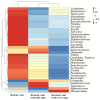Metatranscriptomic Analysis Reveals an Imbalance of Hepatopancreatic Flora of Chinese Mitten Crab Eriocheir sinensis with Hepatopancreatic Necrosis Disease
- PMID: 34071147
- PMCID: PMC8224665
- DOI: 10.3390/biology10060462
Metatranscriptomic Analysis Reveals an Imbalance of Hepatopancreatic Flora of Chinese Mitten Crab Eriocheir sinensis with Hepatopancreatic Necrosis Disease
Abstract
Hepatopancreas necrosis disease (HPND) of the Chinese mitten crab Eriocheir sinensis causes huge economic loss in China. However, the pathogenic factors and pathogenesis are still a matter of dissension. To search for potential pathogens, the hepatopancreatic flora of diseased crabs with mild symptoms, diseased crabs with severe symptoms, and crabs without visible symptoms were investigated using metatranscriptomics sequencing. The prevalence of Absidia glauca and Candidatus Synechococcus spongiarum decreased, whereas the prevalence of Spiroplasma eriocheiris increased in the hepatopancreatic flora of crabs with HPND. Homologous sequences of 34 viral species and 4 Microsporidian species were found in the crab hepatopancreas without any significant differences between crabs with and without HPND. Moreover, DEGs in the hepatopancreatic flora between crabs with severe symptoms and without visible symptoms were enriched in the ribosome, retinol metabolism, metabolism of xenobiotics by cytochrome P450, drug metabolism-cytochrome P450, biosynthesis of unsaturated fatty acids, and other glycan degradation. Moreover, the relative abundance of functions of DEDs in the hepatopancreatic flora changed with the pathogenesis process. These results suggested that imbalance of hepatopancreatic flora was associated with crab HPND. The identified DEGs were perhaps involved in the pathological mechanism of HPND; nonetheless, HPND did not occur due to virus or microsporidia infection.
Keywords: Eriocheir sinensis; hepatopancreas necrosis disease; hepatopancreatic flora; metatranscriptomics sequencing.
Conflict of interest statement
The authors declare no conflict of interest.
Figures








Similar articles
-
Integrative Analysis of Transcriptome and Metabolome Reveals Molecular Responses in Eriocheir sinensis with Hepatopancreatic Necrosis Disease.Biology (Basel). 2022 Aug 26;11(9):1267. doi: 10.3390/biology11091267. Biology (Basel). 2022. PMID: 36138745 Free PMC article.
-
16S rRNA gene sequencing analysis reveals an imbalance in the intestinal flora of Eriocheir sinensis with hepatopancreatic necrosis disease.Comp Biochem Physiol Part D Genomics Proteomics. 2022 Jun;42:100988. doi: 10.1016/j.cbd.2022.100988. Epub 2022 Apr 9. Comp Biochem Physiol Part D Genomics Proteomics. 2022. PMID: 35468457
-
A Meta-Transcriptomics Survey Reveals Changes in the Microbiota of the Chinese Mitten Crab Eriocheir sinensis Infected with Hepatopancreatic Necrosis Disease.Front Microbiol. 2017 Apr 26;8:732. doi: 10.3389/fmicb.2017.00732. eCollection 2017. Front Microbiol. 2017. PMID: 28491058 Free PMC article.
-
Transcriptome analysis of hepatopancreas of Eriocheir sinensis with hepatopancreatic necrosis disease (HPND).PLoS One. 2020 Feb 21;15(2):e0228623. doi: 10.1371/journal.pone.0228623. eCollection 2020. PLoS One. 2020. PMID: 32084152 Free PMC article.
-
First case of hepatopancreatic necrosis disease in pond-reared Chinese mitten crab, Eriocheir sinensis, associated with microsporidian.J Fish Dis. 2016 Sep;39(9):1043-51. doi: 10.1111/jfd.12437. Epub 2016 Feb 5. J Fish Dis. 2016. PMID: 26850704
Cited by
-
Meta-analysis to Unravel Core Transcriptomic Responses in Penaeus vannamei Exposed to Biotic and Abiotic Stresses.Biochem Genet. 2025 Apr;63(2):1459-1478. doi: 10.1007/s10528-024-10772-y. Epub 2024 Apr 3. Biochem Genet. 2025. PMID: 38570440
-
Integrative Analysis of Transcriptome and Metabolome Reveals Molecular Responses in Eriocheir sinensis with Hepatopancreatic Necrosis Disease.Biology (Basel). 2022 Aug 26;11(9):1267. doi: 10.3390/biology11091267. Biology (Basel). 2022. PMID: 36138745 Free PMC article.
-
Comparative Transcriptome Analysis of Eriocheir sinensis from Wild Habitats in Han River, Korea.Life (Basel). 2022 Dec 5;12(12):2027. doi: 10.3390/life12122027. Life (Basel). 2022. PMID: 36556395 Free PMC article.
-
Transcriptome and Genome Analyses Applied to Aquaculture Research.Biology (Basel). 2022 Sep 4;11(9):1312. doi: 10.3390/biology11091312. Biology (Basel). 2022. PMID: 36138791 Free PMC article.
-
Comparative Analysis of the Symbiotic Microbiota in the Chinese Mitten Crab (Eriocheir sinensis): Microbial Structure, Co-Occurrence Patterns, and Predictive Functions.Microorganisms. 2023 Feb 21;11(3):544. doi: 10.3390/microorganisms11030544. Microorganisms. 2023. PMID: 36985118 Free PMC article.
References
-
- Ding Z., Meng Q., Liu H., Yuan S., Zhang F., Sun M., Zhao Y., Shen M., Zhou G., Pan J., et al. First case of hepatopancreatic necrosis disease in pond-reared Chinese mitten crab, Eriocheir sinensis, associated with microsporidian. J. Fish Dis. 2016;39:1043–1051. doi: 10.1111/jfd.12437. - DOI - PubMed
-
- Pan Z.H., Song X.H., Hu X.L., Xue R.Y., Cao G.L., Zar M.S., Kumar D., Feng Y., Wei Y., Zhang W.Y., et al. Pathological Changes and Risk Factors of Hepatopancreas Necrosis Disease of Mitten Crab, Eriocheir sinensis. Fish. Aqua. J. 2017;8:220. doi: 10.4172/2150-3508.1000220. - DOI
-
- Cui L.B., Tang S.L., Qi R.R., Lei Y., Li Y.B., Wang J. Pathological study on “Shuibiezi” disease of crab Eriocheir sinensis. J. Yantai Univ. 2017;30:313–316.
-
- Luo D., Zhang J.Y., Zhao Z.M., Chen H. Relevant research in “Shuibiezi” disease of crab Eriocheir sinensis and microsporidian H. eriocheir. Sci. Fish Farming. 2018;4:61–62.
-
- Soto-Rodriguez S.A., Gomez-Gil B., Lozano-Olvera R., Betancourt-Lozano M., Morales-Covarrubias M.S. Field and experimental evidence of Vibrio parahaemolyticus as the causative agent of acute hepatopancreatic necrosis disease of cultured shrimp (Litopenaeus vannamei) in Northwestern Mexico. Appl. Environ. Microbiol. 2015;81:1689–1699. doi: 10.1128/AEM.03610-14. - DOI - PMC - PubMed
Grants and funding
LinkOut - more resources
Full Text Sources

